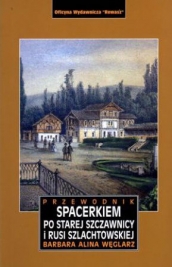Aktualności
NUMER 13: "Kościół św. Stanisława Biskupa i Męczennika w Sromowcach Wyżnych" - Joanna Daranowska-Łukaszewska (ENGLISH)
Pieniny to miejsce pełne zabytkowych budowli o swojej bogatej historii. Bez wątpienia należy do nich również Kościół św. Stanisława Biskupa i Męczennika w Sromowcach Wyżnych. Serdecznie zapraszamy!

Zamów nowy numer magazynu -------------------------->
Buy the new issue of magazine--------------------------->
"Kościół św. Stanisława Biskupa i Męczennika w Sromowcach Wyżnych"
aut. Joanna Daranowska-Łukaszewska
Sromowce Wyżne to wieś należąca do gminy Czorsztyn, na południu województwa małopolskiego, na styku Kotliny Orawsko-Nowotarskiej, Gorców i Pienińskiego Pasa Skałkowego. W samym sercu Pienin Właściwych, u stóp pasma Pienin Czorsztyńskich, na skraju Pienińskiego Parku Narodowego. Ze wspaniałym widokiem na masyw Trzech Koron. Ta bodaj najpiękniej położona wieś pienińska, jest też jedną z najstarszych osad na obszarze, który od XIII wieku należał do klasztoru Klarysek w Starym Sączu.
Najstarsze wiadomości odnoszące się do wsi pochodzą z wieku XIV. Wtedy nazywała się Przekop. W roku 1323 ówczesna ksieni starosądeckich klarysek, Konstancja, wydała przywilej dla sołtysa wsi Przekop. Podobnie jak sołtysi innych okolicznych miejscowości był nim Niemiec, Eberhardt. Zapewne wkrótce potem powstała nowa nazwa wsi – Szram, przez niektórych wywodzona od niemieckiego słowa Schramme, oznaczającego szczelinę skalną. Ale inni znawcy regionu uważają, że nazwę urobiono od imienia współwłaściciela wsi wspomnianego w dokumencie ksieni Konstancji jako soblinus dictus Sram. Podobno w roku 1327 erygowano tu parafię pw. św. Stanisława biskupa i męczennika, ale pierwsze wzmianki o niej pochodzą dopiero z XVII wieku.
W 1334 roku podzielono wieś na dwie części: Sromowce Niżne i Sromowce Wyżne. Z czasem w Pieninach, więc także i w Sromowcach, pojawiła się pasterska ludność wołoska, która przyniosła swoje prawo. Od połowy XIV wieku okoliczne ziemie były własnością królewską, w wyniku czego długie lata w okolicy bioru Polski w roku 1797 zarządzane przez nich ziemie starostwa czorsztyńskiego przejęły władze austriackie, od których w roku 1819 Jan Maksymilian Drohojowski zakupił dobra czorsztyńskie obejmujące Czorsztyn wraz z zamkiem oraz wsie: Kluszkowce, Krośnicę, Hałuszową, Sromowce Wyżne i Niżne. Ten majątek odziedziczył jego syn, Marceli, a jego potomkowie władali nim do roku 1945..
Cały artykuł dostępny w najnowszym 13 numerze magazynu "Polski Region Pieniny".
Serdecznie zapraszamy.
-----------------------------------------------------------------------------------------------------------------------------------------------------------------
ENGLISH VERSION:
"The Church of St Stanislaus Bishop and Martyr in Sromowce Wyżne"
aut. Joanna Daranowska-Łukaszewska
Sromowce Wyżne is a village that belongs to Czorsztyn municipality, situated in the south of Małopolska Region, where the Valley of Orawa and Nowy Targ, the Gorce Mountains, and the Pieniny Rock Belt meet. It lies in the very heart of the Pieniny, at the foot of the Pieniny Czorsztyńskie Ridge, on the edge of the Pieniński National Park. With a magnificent view of the Trzy Korony massif, perhaps the most beautifully situated village in the Pieniny, it is also one of the oldest settlements in an area that already belonged to the Convent of Poor Clares in Stary Sącz in the 13th century.
The earliest records referring to the village date back to the 14th century when the village was known as Przekop. In 1323, Konstancja, the abbess of the Poor Clares from Stary Sącz, issued a privilege for the headman of the village of Przekop. He was a German, much like the headmen of other villages in the area, called Eberhardt. It is quite probable that the new name of the village, Szram, which some derive from Schramme, a German word meaning a fissure in the rock, originated soon afterwards. Yet other experts on the region believe that the place name was coined from the name of a co-owner of the village mentioned in the document of Abbess Konstancja as soblinus dictus Sram. The parish church of St Stanislaus Bishop and Martyr was allegedly erected here in 1327, yet its first mention dates back to as late as the 17th century.
In 1334, the village was split into two parts: Sromowce Niżne and Sromowce Wyżne. With time, the sheep herding Wallachian people arrived in the Pieniny, so also in Sromowce, bringing also their law. From the mid-14th century onwards, land was property of the king, so that the Royal Starost managed the area for many years, and after the conclusion of the Third Partition of Poland in 1797 the domain overseen by the Starost of Czorsztyn was taken over by the Austrian authorities. It was from these that Jan Maksymilian Drohojowski finally purchased the Czorsztyn estate in 1819. This consisted of Czorsztyn itself together with the castle and the villages of Kluszkowce, Krośnica, Hałuszowa, and Sromowce Wyżne and Niżne. It was inherited by his son, Marceli, and his descendants owned it until 1945..
You can read whole article in the latest (13) issue of magazine. Enjoy!




